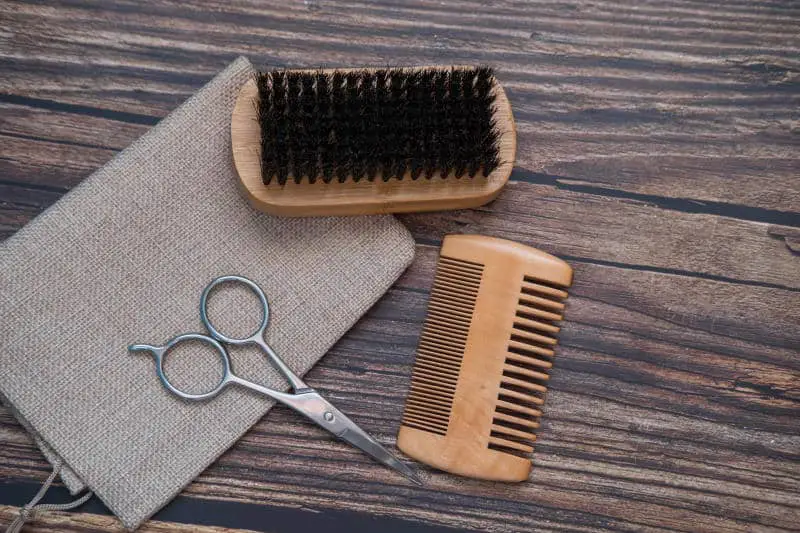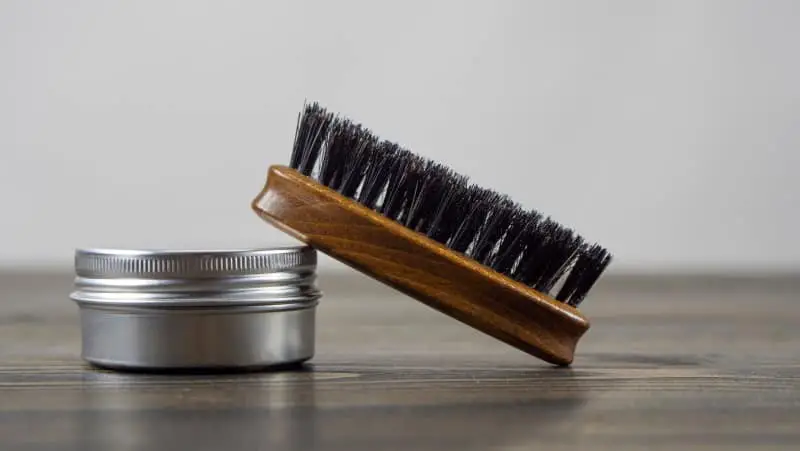If you have a beard, then you must absolutely make sure that you are cleaning it properly and brushing it. You need a beard brush for this, as a hairbrush just isn’t going to cut it. There are two kinds of beard brushes that we can purchase: a horn brush or a boar’s hairbrush.
Cleaning a comb brush is easy—rinse it under the water and apply a couple drops of oil as lubrication to keep it strong. Cleaning a boar’s hairbrush, on the other hand, takes more work. Don’t worry, it isn’t hard work. In fact, there are only five steps:
Step 1: Use a cleaning pick to knock loose bigger pieces of hair and dead skin cells.
Step 2: Use a smaller comb on your brush to get the trickier hairs out.
Step 3: Wash the bristles in a mixture of shampoo and water.
Step 4: Rinse off the shampoo carefully.
Step 5: Set the brush hair side down to dry thoroughly.
With these five simple steps, you can prolong the life of your beard brush and keep it from tugging at your beard hairs. We’ll cover each of these in depth and then some, so don’t go anywhere!
Step 1: Clean With Pick
Most beard brushes won’t come with a pick, so you will have to get one yourself. They’re quite cheap on Amazon. A brush cleaning pick looks like a mini brush, like something that might be used on a child’s doll rather than on a human’s head.
This makes sense, considering you don’t use these on your hair but on the hair of your brush. They’re made out of thin wires which get between the hairs of your brush to knock loose hair and dead skin. Cleaning the top of the hairs on a brush is easy; you can flick them with your thumb to knock loose a lot of the stuff caught, but the lower you go on the bristle the harder it gets
A cleaning pick is inserted at the base of the brush where the hairs poke out. Since the wires of the pick are so small, they can easily fit between these densely packed hairs to knock free all the junk there. You need to clean each group of hair on the brush individually, which makes this the most time-consuming part of cleaning your brush.
Step 2: Clean With Comb
After you finish with the pick, it’s time to do pretty much the same thing again on a slightly larger level. You will need a small comb for this; and while you can use one designed for use on your head, a horn comb made for your beard will already be the perfect size.
Press the comb to the base of the brush and begin combing the hairs. This works to knock loose those bigger pieces of hair, skin, and whatever else has gotten stuck in your brush.
While it shouldn’t make a difference since you shampoo the brush next, you may want to consider using a toothbrush or a cloth to scrub the base of the brush clean too. A lot of what you knock from the hairs will hang on the base and this can sometimes result in pieces of dead skin sticking to the base. If you are doing a quick clean, add this step so you don’t need to shampoo next.
Step 3: Wash With Shampoo
Plug your sink and fill it up with a couple inches of water. Pour in a little bit of shampoo—it doesn’t matter if it is for your head or your beard. The boar’s hair isn’t going to mind either. Don’t use overly hot water, stick to lukewarm or slightly hot. If it burns your skin, it’s too hot for your brush.
It is extremely important that you follow this next step to a T. If you aren’t careful, you can take years off the lifespan of your brush.
The base of a beard brush is wood, and wood rots and decays when it is exposed to too much moisture. A little bit of moisture, such as when you brush your wet beard, is perfectly fine. The wood has likely been treated to withstand this, but you wouldn’t want to submerge it in water.
When the sink is ready, dunk the hair of the brush into the water. Use your free hand to work the shampoo into the bristles.
Step 4: Rinse Off Brush
Be extremely careful with this step as well. Let the sink drain first so you aren’t running water into a pool. This would only cause more splashing and get your brush wetter, and we don’t want that.
Once the sink is drained turn the water on. Again, make sure it isn’t too hot. Rinse off the bristles to remove any traces of the shampoo. This should only take ten or fifteen seconds. This doesn’t need to be very long since the goal is simply a quick rinse, and anything you miss will be small and irrelevant.
Step 5: Let It Dry
Finally, just let the brush dry. Only, you want to make sure that you let it dry the right way. If you sit the brush down on its base, then the water is going to drain down and over the wood. This is just going to end up damaging the brush.
Instead, sit the brush down so that the bristles are facing down. You might need to dangle the brush over the edge of the sink and use a heavier object to hold it in place. Or you may be able to position it so that the hairs themselves hold it up. Do whatever works for you, so long as the hair is facing down it will be just fine.
Come and check on the brush. Once it is dry, you have yourself a freshly cleaned beard brush ready for use.
What Type of Beard Brush is Best?

When it comes to beard brushes, there are two choices. A brush that uses hairs and a comb made out of horn. You could get a comb made out of other materials, but horn is the easiest to clean and will last the longest.
Which of these brushes is the best depends on the size of your beard and what you want out of a brush. A brush made with hair will more easily glide between the hairs of your beard to straight and knock loose anything caught, but a horn comb will be better for shaping your beard into your chosen style.
Rather than choose between the two, I would suggest getting one of each and using them together. This gives you all of the benefits and they won’t break the bank, so it’s extremely affordable.
Does a Beard Brush Have To Be Made From Boar’s Hair?
There is this idea in the bearded subculture that only brushes made with boar’s hair are beard brushes. This is because boar’s hair was most commonly used for these brushes throughout history, so the tradition has continued.
While boar’s hair is a perfect consistency with great stiffness for cleaning a beard, it isn’t the only choice available. Rather than worry about what the hair of the brush is, just worry about whether or not it works when you run it through your beard.
For the most part, if you are looking for a beard brush, then you will find that boar’s hairbrushes are the most common; so you might as well just stick to it.
How Often Should I Clean My Beard Brush?
If you are dry cleaning your brush, then you could clean it every day. Keep in mind that dry cleaning here means to clean it without water and should not be confused with dry cleaning such as we do with our clothes. Using a pick or a comb in your brush can be a regular step if you want.
As for shampooing your brush? Try to avoid cleaning this way as often. Once a month is perfectly fine and once every two months is probably even better, honestly. The hairs of the brush are much coarser, and they don’t need to be softened with shampoo as much because this coarseness is actually beneficial.
Try to avoid over-cleaning if you can help it. A hairbrush goes through a lot more hair and it gets dirtier much faster. Your beard isn’t nearly as thick (normally), and so it takes longer for a beard brush to get dirty.
Conclusion
It takes time to clean your beard brush, but when you do it properly it will last you for years. A single beard brush could easily last you five to ten years (and sometimes even more!) if you maintain it properly.
You only need to clean it this way once a month or every other month, so set it on your calendar and keep that brush clean!

